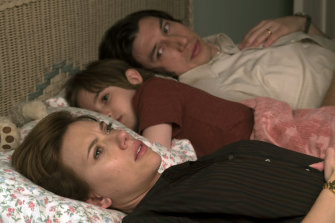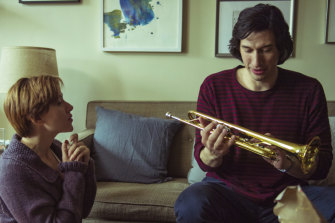Raw, brittle: Adam Driver dissects a failed marriage story
MARRIAGE STORY ★★★½
136 minutes, (M)
Selected cinemas
This week brings two new movies starring Adam Driver, both of which follow him through a maze far more complex than it first appears. In The Report, he’s a Washington insider investigating the CIA’s use of torture; in Marriage Story, his character embarks on the equally exhausting process of getting divorced.
Scarlett Johansson and Adam Driver play a divorcing couple in the drama Marriage Story.
Both films are founded on fact, up to a point. While Marriage Story is no literal autobiography, its writer-director Noah Baumbach (While We’re Young) has acknowledged finding inspiration in his divorce from Jennifer Jason Leigh – even if he hadn’t said as much, it's clear the subject-matter lay close to home.
Baumbach’s stand-in, played by Driver, is stage director Charlie Barber, who runs a successful off-Broadway theatre company with his wife Nicole (Scarlett Johansson) as his leading lady. Charlie is content with the status quo but Nicole, who comes from a showbiz family, wants to give Hollywood one more shot. When she’s cast in a TV pilot (something about sentient plants) she seizes the chance to make a break, taking along young son Henry (Azhy Robertson).
Marriage Story is thus a tale of two cities, New York and Los Angeles – like several films by Woody Allen, whose influence is all over the film and Baumbach’s work in general. But Baumbach delivers what Allen only ever promised, a realistic picture of a specific class of well-off American sophisticates. As ever he’s alert to matters of status, what it means to be a big-shot in one context and a nobody in another.
Baumbach is a filmmaker of two sides, both a humanist who understands that everyone has their reasons and a brittle satirist with a knack for lines that sound like cartoon captions (“The Japanese are doing some really interesting tequilas at the moment”). The funniest material here involves the lawyers, played by actors ideal for their roles: Ray Liotta as a heavy hitter who looks and talks like a mafioso, Laura Dern as a New-Agey but ruthless feminist, and Alan Alda as a gently seedy old-timer.
These are caricatures but nuanced ones, without the reductive sourness which can be Baumbach's weakness: he’s able to make them funny without cutting them down to size. You can feel the actors’ joy in playing these long, almost theatrical scenes – and the director’s joy in seeing them take the script to a new level.
Dissecting marriage: Scarlett Johansson and Adam Driver in Marriage Story. Credit:Netflix
The humour comes as a relief from the central drama, which is moving and gruelling by turns. The title Marriage Story is less incongruous than it sounds: following the divorce step by step is a means for Baumbach to analyse what came before, as an autopsy might reveal the condition of the living patient.
A running time of well over two hours, made possible by Netflix, gives him room to explore everything these people meant to each other and still do. But while Charlie and Nicole aim to keep things civilised, it’s no spoiler to say their conflict gradually escalates: a climactic shouting match has a rawness rarely seen in American films with major stars.
Baumbach tries to be even-handed and succeeds to a point: Johansson does some of the best acting of her career, especially in an early monologue where Nicole articulates some of the frustrations she’s held back. But finally Charlie is the dominant figure, if not necessarily the more sympathetic: much of the film’s impact springs from Driver’s peculiar definite quality, the conviction he brings to each gesture.
Being a director is all about choices and it’s easy to believe in Driver as a success in this profession – though a show-stopping scene near the end reveals Charlie is also a gifted performer. This seems a bit unnecessary, especially as the theme isn’t much pursued elsewhere. But having shot Driver’s moment of glory, it’s forgivable that Baumbach couldn’t bring himself to leave it out.
Source: Read Full Article

